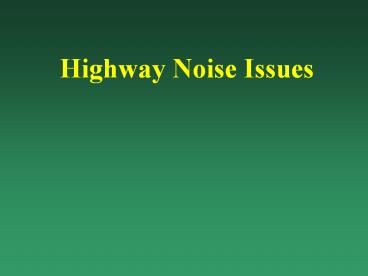Asphalt Pavement Patching - PowerPoint PPT Presentation
Title:
Asphalt Pavement Patching
Description:
Highway Noise Issues Quantifying Noise Measuring Pavement Noise Mitigation Methods Comparison of Pvmt. Surfaces Arizona s Quiet Pavements A 3dB(A) reduction ... – PowerPoint PPT presentation
Number of Views:61
Avg rating:3.0/5.0
Title: Asphalt Pavement Patching
1
Highway Noise Issues
2
Public is Demanding Quieter Pavements!
Governors Derby Breakfast, Louisville, KY
3
Presentation Outline
- Quantifying Noise
- Measuring Pavement Noise
- Mitigation Methods
- Comparison of Pvmt. Surfaces
- Arizonas Quiet Pavements
4
How Do We Quantify Noise?
5
How Do We Quantify Noise?
The Decibel Scale
Discomfort
Conversation
Hearing Threshold
Pain Threshold
6
Increasing the Decibel Level by 10 Doubles the
Sound Intensity
The Decibel Scale
Conversation
Chain Saw
Train
7
75 Decibels
The individual is exposed to a combined total 78
Decibels
75 Decibels
8
The Decibel Scale
A reduction of 3 dB(A) is like doubling the
distance from the noise.
67 dB(A)
50 ft
9
The Decibel Scale
A reduction of 3 dB(A) is like doubling the
distance from the noise.
67 dB(A)
- 3 dB(A) 64 dB(A)
100 ft
10
A 3dB(A) reduction corresponds to
- doubling the distance
- reducing traffic volume by 50
- reducing traffic speed by 25
11
- FHWA - Noise Abatement Criteria
- 67 dB(A)
- this is not an absolute value or design
standard, only a level where noise mitigation
must be considered - For new construction or reconstruction
- (ISO 11819-1)
12
Side-Line Measurements
- Statistical By-pass Method (ISO 11819-1)
13
Close-proximity (CPX) Method
14
NCAT Close Proximity Noise Trailer
15
Comparison of CPX versus Side-Line
MeasurementsIndianapolis - September 2003
Offset 23 dB(A)
16
What Can Be Done to Mitigate Pavement Noise?
- Distance
- Obstructions
- Noise Walls
- Earth Berms
- Trees/ Shrubs
- Control at the Source with Pavement Surface
17
Controlled Through Distance
18
Controlled Through ObstructionsAverage 1 dBA
for each 2 ft of Wall Above Line of Sight
Wall 10 above LOS
19
Noise Walls
Effective only for those in line-of-sight.
Does not reduce noise at source.
20
Sound or Noise Walls
21
Noise Barrier Effectiveness Must Justify Expense
- Walls
- top 10 States in 1998 spent over 1.3M per mile
- do nothing to eliminate the noise at the source
- Earth Berms
- require a lot of land if very high
- Vegetation
- takes a long time to develop
- 200 thick would only achieve a 10 dB reduction
22
Controlling At the Source
23
Pavement / tire noise has been studied for well
over 30 years and several large databases have
been compiled in the last decade. NCHRP
Synthesis 268 is a summary of the research
findings of this extensively studied topic.
24
Conclusions In general, when dense-graded
asphalt and PCC pavements are compared, the
dense-graded is quieter by 2 to 3 dB(A)
A 3dB(A) reduction corresponds to - doubling
the distance - reducing traffic volume by
50 - reducing traffic speed by 25
25
Conclusions Open-graded asphalt shows the
greatest potential for noise reduction for passby
noise. Reduction when compared to dense-graded
asphalt ranged from 1 to 9 dB(A).
A 9dB(A) reduction corresponds to - a
reduction in traffic noise by almost 50!
26
I-64 Noise Study in Louisville
- By Local Engineering Firm
- Readings taken before and after B/S Overlay
- A 4-6 decibel reduction between old PCC and new
asphalt
27
OGFCs Reduce Noise, Eliminate Hydroplaning,
Increase Wet Friction, and Minimize Spray
28
I-74 in Ohio Driving on Dense HMA onto OGFC then
back onto Dense HMA
29
Texas Highway Driving on Dense Graded Mix then
onto OGFC
30
Is It Cost Effective?
- A decrease of 2 dB means a reduction of five feet
in wall height or for a mile of pavement a
reduction of 528,000 (Average of 20/sf)
31
Summary Effect of Pavement Surface
- OGFC is the quietest surface type. (Wayson, NCHRP
Synthesis 268) - SMA has also proven to be a quiet surface.
(Wisconsin DOT, 1993) - Dense graded HMA surfaces are quieter than PCC
pavements. (Hibbs and Larson, Report
FHWA-SA-96-068, May 1996)
32
Arizona DOT Uses ARFC to Provide Quiet Pavements
- ADOT is Spending 34M to Overlay PCCP in the
Phoenix Metropolitan - The ARFC is Minus 9.5mm 9-9.5 Binder
- 12.5 mm Thick When Used on Flexible Pavement
- 25 mm Thick When Used on PCCP
- ADOT Uses Pavement Type (ARFC) as a Noise
Mitigation Strategy (4 dBA)
33
(No Transcript)
34
Recorded Noise Levels from CPX
35
Recorded Noise Levels from CPX
36
Summary
- Highway noise very important to public
- Small changes in dB(A) level very noticeable
- reduction of 3dB(A) like doubling distance or
halving traffic - Sound barriers expensive and not very effective
- Controlling Noise at the Source is Best Option
- Dense HMA 2-4dB(A) quieter than PCC
- OGFCs 1-9dB(A) quieter than Dense HMA































